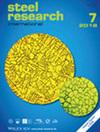Impact of Chemical Composition Changes during Ultrasound Atomization and Laser Powder Bed Fusion of Low Alloy Steel
IF 1.9
3区 材料科学
Q2 METALLURGY & METALLURGICAL ENGINEERING
引用次数: 0
Abstract
This study investigates the effect of changing the chemical composition during ultrasonic atomization (UA) and laser powder bed fusion (LPBF) of low‐alloy steel. UA is used to produce a spherical powder with d50 equal to 49 μm. During UA, the chemical composition of the material changes, which is associated with selective evaporation of Mn from 1.42% to 0.35% and B from 0.0012% to <0.0001%. Thermodynamic calculations confirm that during atomization, mostly Mn and Fe evaporate. To achieve a high density of 3D printed parts, in situ remelting in LPBF is applied. A microstructure consisting of fine grains of tempered martensite and bainite in crystallized meltpools is observed. The selected high‐quality LPBF samples are austenitized in the temperature range of 900–1200 °C for 20 min and quenched in oil. The samples are characterized by light and scanning electron microscopy, as well as Vickers hardness. Changes in chemical composition result in a decrease in the hardenability of the material, and quenching only at 1200 °C produces a martensitic microstructure. LPBF samples show a hardness higher than that of the postheat‐treated sample, but still significantly lower than that of the as‐delivery condition, which is related to the change in chemical composition.低合金钢超声雾化和激光粉末床熔融过程中化学成分变化的影响
本研究探讨了在低合金钢超声雾化(UA)和激光粉末床熔融(LPBF)过程中改变化学成分的影响。超声雾化用于生产 d50 等于 49 μm 的球形粉末。在 UA 过程中,材料的化学成分发生了变化,锰从 1.42% 蒸发到 0.35%,硼从 0.0012% 蒸发到 0.0001%。热力学计算证实,在雾化过程中,大部分锰和铁会蒸发。为了实现 3D 打印部件的高密度,在 LPBF 中采用了原位重熔技术。在结晶熔池中观察到由细小的回火马氏体和贝氏体晶粒组成的微观结构。选定的高质量 LPBF 样品在 900-1200 °C 的温度范围内奥氏体化 20 分钟,然后在油中淬火。样品通过光镜和扫描电子显微镜以及维氏硬度进行表征。化学成分的变化导致材料的淬透性降低,仅在 1200 °C 下淬火会产生马氏体微观结构。LPBF 样品的硬度高于热处理后样品的硬度,但仍明显低于交货时的硬度,这与化学成分的变化有关。
本文章由计算机程序翻译,如有差异,请以英文原文为准。
求助全文
约1分钟内获得全文
求助全文
来源期刊

steel research international
工程技术-冶金工程
CiteScore
3.30
自引率
18.20%
发文量
319
审稿时长
1.9 months
期刊介绍:
steel research international is a journal providing a forum for the publication of high-quality manuscripts in areas ranging from process metallurgy and metal forming to materials engineering as well as process control and testing. The emphasis is on steel and on materials involved in steelmaking and the processing of steel, such as refractories and slags.
steel research international welcomes manuscripts describing basic scientific research as well as industrial research. The journal received a further increased, record-high Impact Factor of 1.522 (2018 Journal Impact Factor, Journal Citation Reports (Clarivate Analytics, 2019)).
The journal was formerly well known as "Archiv für das Eisenhüttenwesen" and "steel research"; with effect from January 1, 2006, the former "Scandinavian Journal of Metallurgy" merged with Steel Research International.
Hot Topics:
-Steels for Automotive Applications
-High-strength Steels
-Sustainable steelmaking
-Interstitially Alloyed Steels
-Electromagnetic Processing of Metals
-High Speed Forming
 求助内容:
求助内容: 应助结果提醒方式:
应助结果提醒方式:


